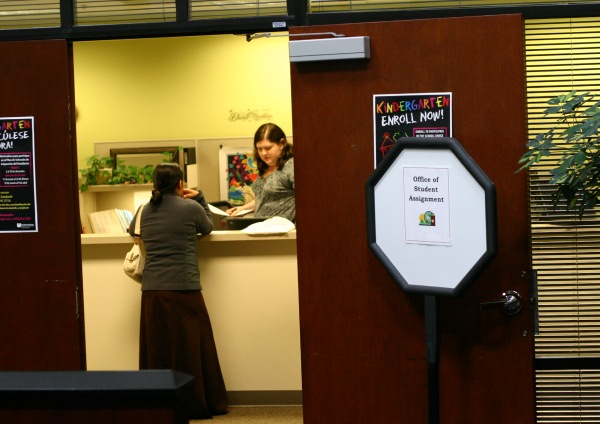Too many choices can be overwhelming, and Regan Peek can testify to that. She’s a mother in her late twenties, and like every other parent of a rising kindergartener in Wake County, she had to look at a list of five schools and order them in the way she thought best for her child.
“It was a pretty simple process, but the choices were scary. I wish they’d just tell me where to go,” she said after making her choices this week at Wake County’s Student Assignment office in Cary.
As of mid-day Tuesday, 7,906 kindergarten families had participated in the first round of the choice process, which ends this Friday. Almost 900 rising kindergarteners were assigned during the magnet selection process in January. All told, nearly 75 percent of the 12,000+ projected kindergarten families have participated in the process.
Families who are already in the public school system don’t need to participate, but some are choosing to. More than 16,000 students (including rising kindergarteners) have participated in the choice process overall. The majority of students participating not at the kindergarten level are rising sixth and ninth graders.
Staff and school board members noted that about 15 percent of students at those grade levels are participating in the choice process, foregoing their current assignment. In grades that aren’t moving up to a higher school (such as 1-5, 7-8 and 10-12) participation is around 5 percent.

Parent Felipe Limas is helped through the selection process by a front office worker. Photo by Will Huntsberry.
At Tuesday’s work session Superintendent Tony Tata said those numbers are right on track with the projected numbers staff developed after a test drive of the controlled-choice plan.
The choice assignment plan is managed by two directors, four senior administrators, a temporary call bank staff and a data manager at each school.
“The volume of calls has just sky-rocketed” since the new plan has been on the table, said Senior Administrator Dawn Baker. “It’s just that it’s new. Whenever you enact something new the parents need to understand what’s going on. We’re here to make sure we answer all those questions.”

Dawn Baker, a Senior Administrator, works at her desk in the student assignment office. Four senior administrators control the process of student assignment at all 165 Wake County Schools. Photo by Will Huntsberry.
“Reactions have been mixed from parents. But, nine times out of ten they are grateful after we walk them through the process,” she said, referring to her call bank staff and data managers.
While many of the parents the Record spoke to at the student assignment office this week were grateful for the help staff provided, reaction during public comment at board meetings has been harsh at times.
At a Dec. 20 meeting, Hal Reed, a parent of two at Joyner Elementary Magnet School, spoke out about his bad experience. Because his children wouldn’t be able to go to nearby middle and high schools under the new feeder patterns, he needed to participate in the choice process.
“I called the number. The person on the other end was certainly trying to be helpful. But she just didn’t know her facts,” said Reed. “I asked her a bunch of questions and she got confused. She said ‘well, I think it’s on the website.’ I hung up the phone, looked on the website and saw none of the information I needed.”
Reed’s diagnosis: “There’s a big rush to make this happen before anyone can say no and stop it.”
For Peek, it wasn’t the process that was difficult. It was the decision-making.
“Sometimes for me, too many choices is too much to know what to do with,” she said. “Ultimately, I looked at the school’s test scores and whether they have after-school care.”
The second round of choice begins March 13 and, unless much changes, roughly 25 percent of rising kindergarteners will need to participate. School officials say reaching out to those 25 percent and helping them make informed decisions could be the toughest part of the assignment process yet. If they don’t make a choice, they’ll end in whatever schools have leftover seats.
